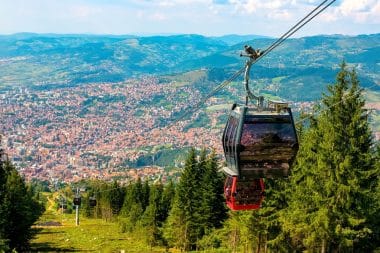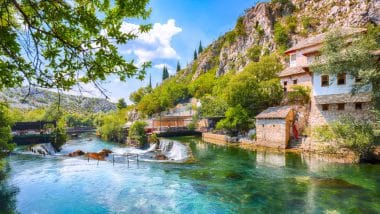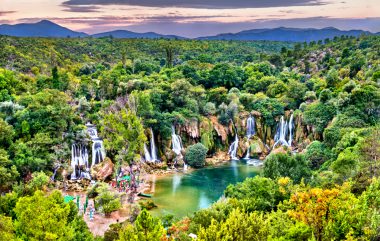Bosnia and Herzegovina is greatly underestimated as an attractive holiday destination. When people hear Bosnia and Herzegovina, many still think of the Balkan War, which brought a lot of destruction, and also a lot of suffering, especially in the picturesque city of Mostar, and in the capital Sarajevo. But more than 20 years after the end of the war, much damage was repaired. In the meantime, Bosnia-Herzegovina attracts visitors with a breathtakingly beautiful landscape, warm people and delicious Balkan cuisine. Which cities and sights you should not miss in Bosnia-Herzegovina can be found here.
The historic capital Sarajevo

With just under 300,000 inhabitants, Sarajevo is manageable and easy to manage on foot. Travelers no longer have to worry about safety here: since the end of the Balkan war in 1995, the city has been no more dangerous than other European capitals. Walking through the historic city center, you quickly feel like you’re in a fairy tale from 1001 nights. The Baščaršija, the historic bazaar whose entrance is the Sebilj Fountain – the city’s landmark – could also be located in Turkey .
The Ottoman heritage can still be felt so strongly here today. The bazaar is lined with cafés where traditionally strong Turkish coffee with lokum can be enjoyed. In addition, hand-cut copper souvenirs can be purchased. The Gazi Husrev Beg Mosque, built in 1530, is one of the oldest of the city’s 200 mosques, and definitely worth a visit. We continue to the nearby Lateinerbrücke. In 1914, the assassination attempt on the Austrian Archduke Franz Ferdinand, which triggered the First World War, was carried out here. A museum at this point provides information about the details of the attack. You should also plan enough time to enjoy the beautiful nature outside the city center.
Sarajevo is located in a depression. The surrounding mountains are not only scenic: from there you also have a wonderful view down to the city center. The Trebević cable car leads up to the local mountain Trebević. Lost Places fans hike from here on signposted paths to the 1984 Olympic bobsleigh run, which is now sprayed over with graffiti and connects more and more with the surrounding nature.
Mostar: the divided city
The landmark of the city of Mostar is without question the Stari Most, i.e. the Old Bridge. Built in 1566, it is a true masterpiece of the architecture of the time, spanning the two districts divided by the Neretva River. Already during the construction period, this bridge was called a symbolic connecting element between the eastern and western hemispheres. It still connects the Christian with the Muslim world, the Croatian-influenced western part with the Bosniak-influenced eastern part of the city. During the Balkan crisis, the historic building was destroyed, then rebuilt according to the original model and reopened in 2004. Since 2005, the bridge has been part of the UNESCO World Heritage Site. The stone bridge is home to small shops, cafes and Ćevapčići roasters. Connoisseurs say that you can eat the best ćevapčići in the country here. Those who come in the summer months can also work as bridge jumpers together with the local youth. Only those who dare to jump from Stari Most into the Neretva are considered a real guy here: the male youth prefers to jump in front of an audience of local girls and amazed tourists.
The Buna spring in Blagaj

Only ten kilometers from Mostar is the village of Blagaj. Here, the Buna River rises from a karst spring. This natural spectacle alone is very impressive. A Turkish sultan was also very enthusiastic about this spot: so much so that he had the dervish monastery Tekija built here in the 17th century. It is located directly on the shore of the spring lake. Behind it is a cave that can be explored with a rented boat. Afterwards, it is worth climbing to the medieval fortress of Stjepan grad. Since an earthquake in 1835, there are only ruins to see here, but the view down to the spring is very beautiful. About a kilometer away is the center of Blagaj with a bazaar and a mosque complex, which used to house a harem. Many of the stone houses in the village were built between 1500 and 1760, which is why a walk through the village is quite impressive.
The dramatic waterfalls of Kravica

Very close to the village of Studenci, the Kravica waterfalls, which are under nature conservation, plunge no less than 28 meters into the depths. Swimming is allowed in the wide outlet pool. However, the water there is very cool: it hardly reaches more than 15 degrees. This is because the water cannot heat up any further due to the constant falling movement. If you don’t want to swim, you can rent a kayak. The waterfalls extend over an area of 120 meters wide, which looks quite dramatic. Around the waterfalls, the vegetation is very rich.
Pearl on the Adriatic: Neum
In the very south of the country lies the small town of Neum, Bosnia-Herzegovina’s only access to the sea. The so-called Neum Corridor leads to the Adriatic Sea. To the left and right you are surrounded by Croatian territory. On the gently sloping 20-kilometre-long coastline, there are breathtaking pebble beaches in front of crystal clear water. There are a lot of restaurants in the city that offer a view out to the sea. Here you can enjoy fish and Balkan specialties such as burek, a dough roll filled with meat, cheese or spinach, and sarma, vine leaves stuffed with minced meat, rice or fish.
Recommendations
- Discover Sarajevo’s best cafes, artisan workshops, and quaint streets on a walking tour of the capital.
- Visit the Unesco heritage and bird sanctuary of Hutovo Blato – the largest of its kind in southeastern Europe and a permanent home for owls, Greek partridges and herons.
- Hike along the Rakitnica Gorge, south of Sarejevo, and enjoy spectacular views of mountain streams, waterfalls, and the Dinaric Alps.
- Be enchanted by the turquoise river that flows under the elegant Stari Most (Old Bridge) of the Mostra.
- Take a dip and have a picnic lunch at the stunning Kravica waterfall.
Tips
Bosnians tend to be very friendly, but if you’re having a conversation about politics or history, be aware of who you’re talking to – tensions can always be present. In Herzegovina, you shouldn’t just refer to Bosnia and Herzegovina as Bosnia. When you enter a church or mosque, make sure that you are dressed respectfully. Women should cover their heads with scarves when visiting mosques, and both men and women must take off their shoes.
The most important facts about Bosnia and Herzegovina in brief
Population: 4.6 million
Languages: Bosnia & Herzegovina, Serbian, Croatian
Time: GMT +1 (GMT +2 in summer)
Visas: Visa for Bosnia and Herzegovina
International airports: Sarajevo (SIJ), Banja Luka (BNX) and Mostar (OMO).
Money: Bosnia & Herzegovina Convertible Mark (KM/ BAM)
In Bosnia and Herzegovina, you usually pay in cash. There are plenty of ATMs in the big cities where you can withdraw cash if you need to, but don’t expect restaurants and shops to accept credit cards, and in small towns, you’ll struggle to find ATMs on your own. Euros and US dollars are useful. Waiters are paid very low salaries, so a tip of 10% or more is highly appreciated. The same applies to taxi drivers.
Best time to travel and means of travel
The climate in Bosnia and Herzegovina varies dramatically depending on where you are in the country. Herzegovina – the area in the south near the Adriatic Sea enjoys a Mediterranean climate with warm, sunny, dry weather and mild winters. Bosnia in the north has more continental conditions – warm summers and very cold, snowy winters. However, individual mountains are surrounded by microclimates. Unless you’re planning on skiing, summer is generally the best time to visit Bosnia and Herzegovina, and unlike other more established destinations, you don’t have to deal with expensive prices and crowds in the “high season”.
By train: Since the railways have been hit hard by the war and repairs are still pending on many lines, train traffic in Bosnia and Herzegovina is restricted. The existing routes are reliable and cheap, albeit very slow. The train journey between Sarejevo and Mostra is particularly scenic. Sarajevo is well served by a tram network.
By road: Every town and village in Bosnia and Herzegovina is served by a private or public bus system. The buses run more frequently than trains, but are less comfortable and about the same price for comparable trips. In the larger cities, a car can be rented. The roads are generally well maintained, but don’t expect fast driving times as there are no highways.
Accommodation in Bosnia and Herzegovina
Hotels can be found in all major cities. Many of the large hotels built during the socialist era are not very comfortable, so it is worth looking for private rooms and family-owned apartments. Feel free to knock on the door if you see a sign that says sobe/ zimmer/ rooms/ camere. There is a huge potential for ecotourism in Bosnia, but unfortunately only a few campsites. However, there are numerous mountain huts that are good starting points for hikers.
Food and Drink
Meat lovers are in good hands in Bosnia and Herzegovina and can enjoy specialties such as cevapi (a lamb and beef mixture somewhere between kebab and sausage), jagnjetina (lamb roasted on a skewer) and begova corba (veal and vegetable soup). Vegetarians will have a hard time, as even so-called vegetable dishes are often prepared with pieces of bacon or smoked meat. Local wines and beers are very cheap in Bosnia and Herzegovina, Turkish coffee is very popular.
Vaccinations
There are no legal requirements for vaccinations in Bosnia and Herzegovina, but it makes sense to be up to date with hepatitis A, tetanus, and diphtheria vaccinations.


